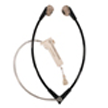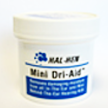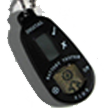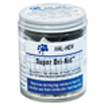Care and Maintenance Kit In order for hearing aids to be of any benefit, they must be functioning and must be maintained in good working order. Included with the purchase of the hearing aids is a maintenance kit. This includes:
A plastic Stethoscope: This allows the parent to listen to the hearing aid and make sure the hearing aid is in good working order.
Battery Tester: This allows you to check the battery and make sure it is working properly.
Dry Kit: This container contains silica gel packs which will keep the hearing aids dry and remove any moisture in the hearing aid.
Earmold Blower: Blows air through the earmold and tubing to remove any accumulated moisture.
Dri-Aid: The Dry Aid is a container filled with beads which absorb moisture from the hearing aid.

Stethoscope

Dry Kit

Earmold Blower

Battery Tester

Dri-Aid
Daily Hearing Aid Checklist
A daily checklist is important, especially with your children, as they may not be able to tell you that the hearing aid is not functioning properly. Your audiologist will demonstrate this for you at the time of the fitting.
- Look for signs of damage to the hearing aids and earmold. Are there cracks or broken parts on the aid? Is the
earmold plugged with wax? Is there moisture in the earmold tubing? Is the tubing from the earmold hard or stiff? - Use your battery tester to check the battery. It is a good idea to put the sticker from the battery on the
calendar on the day you change the battery. This will give you a good indication as to how long the batteries are
generally lasting. - Place the battery in the hearing aids and turn the hearing aids on. Listen to the hearing aid with the
stethoscope. If the volume control is active, slowly increase and decrease the volume while you talk. Say the sounds
“aw”, “oo”, “ee”, “sh”, “ss”, “mm”. Listen for any crackling/static, or intermittent sounds.
Hearing Aid Care
- Wipe the hearing aid with a towel or Kleenex regularly to keep it clean.
- Store the aid in the dry-kit provided to keep it dry.
- Turn the aid off when not in use by opening the battery door.
- Avoid getting the aid wet.
- Remove the aid when using hairspray or around X-ray equipement.
- When the aid is not in the ear, keep it in the dry-kit or in the case provided to avoid loss and to ensure pets
will not eat it. - Do not attempt repairing the aid yourself as this may void the warranty.
- Insure your hearing aids through your house insurance for loss.
Earmold Care
Before cleaning the earmold, remove it from the aid by disconnecting the tubing from the earhook. (your audiologist will demonstrate this for you).
- Wash the earmold with a mild detergent or antibacterial soap.
- Let the earmold dry completely before reattaching it to the aid. It may be a good idea to wash the earmold at
night to allow it to dry overnight. - Use the earmold blower provided to blow through earmold tubing to ensure all the moisure is removed from the
tubing. - Remove any wax from the openings of the earmold.
- If the tubing is stiff or cracked, have it replace by your audiologist.
Battery Care
- Be sure that the batteries you purchase are Zinc Air Hearing Aid Batteries.
- Use the proper battery size: 675 (blue package), 13 (orange package), 312 (brown package), 10 (yellow package), 5
(red package). Most Behind-the-Ear hearing aids will use a 675, 13 or 312 battery. You audiologist will advise you
of the proper battery size required. - Buy fresh batteries from a reliable source. Check the expiry date on the back of the cards of batteries to ensure
that the batteries have not expired. If there is no expiry date, I would not advise buying them as you do not know
how old they are. - Discard of old batteries by throwing them in the trash. Hearing aid batteries are also recyclable. They can be
dropped off at your audiology clinic or at a local Staples. - Batteries are to be stored at room temperature in a dry place.
- The sticker on the battery is intended to keep the batteries fresh. Do not remove the sticker until you are about
to insert it in the aid. Once the sticker is removed from the aid, put the sticker on the calendar on the day the
battery was changed in order to monitor battery use. Please note that once the sticker is off the battery, the
battery is draining and it does not save the battery to put the sticker back on. - Once the sticker has been removed, let the battery sit for a few minutes before inserting it in the aid. This
allows air to fully activate the battery and may increase the life of the battery slightly. - Carry extra batteries with you at all time.
- Keep batteries out of reach of children and pets.
Troubleshooting
Problem
Dead/No Sound
Cause & Solution
- Battery may be dead; try replacing battery
- Battery may be in backwards; reinsert battery
- Earmold/tubing may be plugged with wax/moisture; clean earmold and/or use earmold blower to clear tubing
- Hearing aid not turned on; If the aid has an on/off switch, ensure that the aid is in the on position.
- Damaged internally; return to audiologist
Problem
Weak/Intermittent Sound
Cause & Solution
- Battery may be dead; try replacing battery
- Battery may be in backwards; reinsert battery
- Earmold/tubing may be plugged with wax/moisture; clean earmold and/or use earmold blower to clear
tubing - Hearing aid not turned on; If the aid has an on/off switch, ensure that the aid is in the on position.
- Damaged internally; return to audiologist
Problem
Crackling/Frying/Static Sound
Cause & Solution
- Low battery; try replacing battery
- Damaged internally; return to audiologist
Problem
Whistling/Feedback Sound
Cause & Solution
- Earmold not in the properly; reinsert earmold making sure the earmold is in the ear correctly
- Earmold loose; return to audiologist for new earmold
- Earmold tubing cracked; return to audiologist to replace earmold tubing
- Excessive wax in the earcanal; have was removed by physician, ENT or Audiologist
- Volume too high; if the aid has a volume control make sure the aid is not turned up to loud
- Damage internally; return to audiologist
Hearing Maintenance
Wear custom or earmuff hearing protection in areas of excessive noise. Excessive noise exposure will damage hearing
further.
Wear hearing aids during all waking hours. The auditory system requires auditory stimulation. Children (and adults)
need to hear speech and all environmental sounds in order to grow, develop, and learn.
Have your child’s hearing retested annually (once per year), or more frequently if it is recommended by your
audiologist.